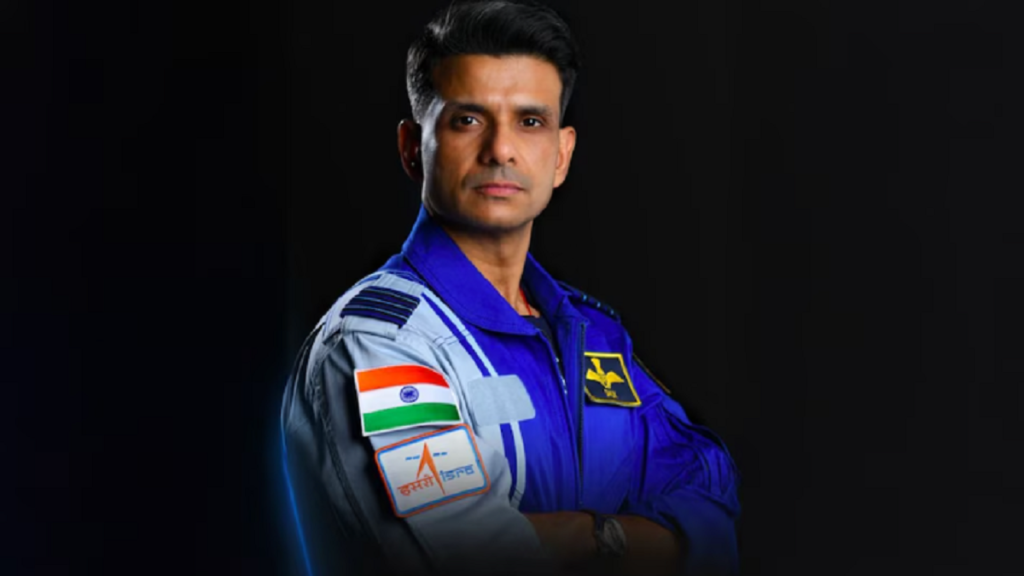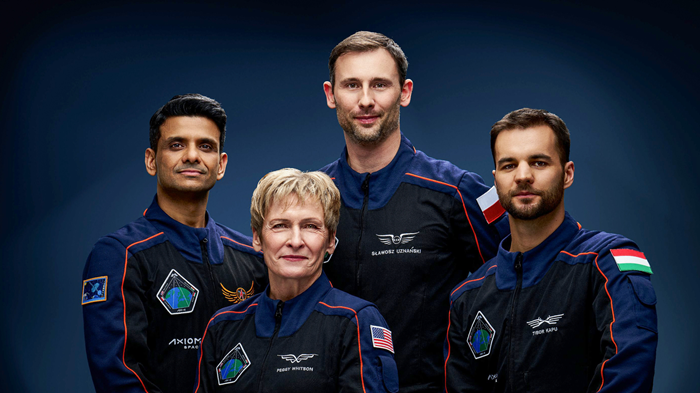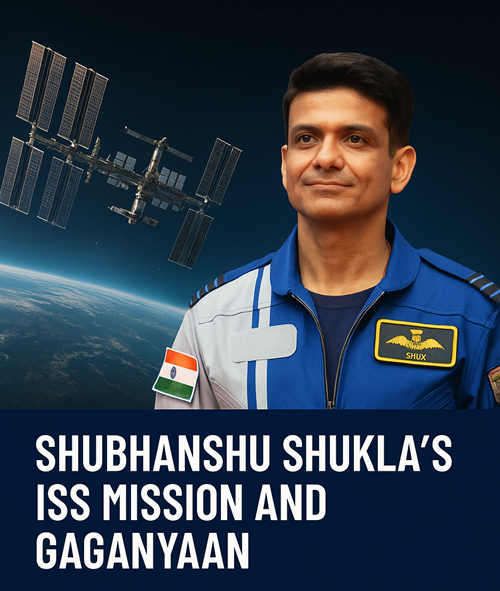Meet Shubhanshu Shukla – The Man Carrying India’s Space Aspirations
When Group Captain Shubhanshu Shukla suited up for the Axiom-4 (Ax-4) mission to the International Space Station (ISS), he didn’t just step into space—he stepped into history. An ace pilot from the Indian Air Force, Shukla is now the second Indian ever to travel to space, following in the legendary footsteps of Rakesh Sharma (1984).
But what sets his mission apart is not just symbolism—it’s what he’s doing up there that truly matters for what ISRO has been quietly preparing down here: India’s first human spaceflight mission—Gaganyaan.

Why This Mission Matters: Real Lessons > Simulations
Space missions aren’t just about countdowns and launches—they’re about precision, survival, and learning from the unknown. While ISRO has built highly sophisticated simulators for Gaganyaan, as scientists admit, there’s still a 1% gap—a gap that can only be bridged by real-time experience in microgravity.
That’s exactly what Shukla is bringing back.
By participating in Axiom’s private space mission, he gets direct exposure to:
- Microgravity conditions
- Life support systems in action
- Docking operations at the ISS
- Crew health monitoring and emergency drills
This is not just a test flight—it’s a masterclass in human space survival. Every moment Shukla spends aboard the ISS is another byte of real, human-driven data ISRO can integrate into Gaganyaan.
Made in India: Scientific Experiments in Orbit
Now here’s where things get really exciting.
India has sent seven science experiments with Shukla to the ISS—mini labs that are tackling everything from agriculture to human health:
Space Farming
Seeds of moong and methi are being observed to understand how Indian crops behave in zero gravity. This could be vital for long-term missions and even space agriculture on Mars or the Moon someday.
Microbes & Microgravity
Tiny organisms like cyanobacteria, microalgae, and even tardigrades (the toughest creatures on Earth) are being tested to understand their survival capabilities in space. They may one day help in oxygen generation and waste recycling on space stations.
Human Physiology & Mental Health
One study looks at muscle loss, another at cognitive behavior under screen exposure—key concerns during prolonged spaceflights. Imagine trying to function normally with your muscles weakening and mind fogging—this research helps prevent that.
Medical Research in Orbit
Perhaps the most intriguing: India is studying how diabetes behaves in space using real-time glucose monitors. Another study looks at early cancer detection markers. These could revolutionize how we understand and fight chronic diseases—not just in space, but right here on Earth.
International Collaboration, Indian Pride
Shukla is not alone on this voyage. He’s joined by mission commander Peggy Whitson (USA), Poland’s Slawosz Uznański, and Hungary’s Tibor Kapu.
Aboard the SpaceX Dragon capsule, they lifted off on June 25, 2025, from Kennedy Space Center. After a smooth docking with the ISS, the mission entered its crucial 14-day science phase.
This is India’s soft-power moment in space—sharing research, insights, and innovations with the global space community while keeping national interests at the forefront.

How This Connects to Gaganyaan
Now, let’s circle back to Gaganyaan.
ISRO is aiming to launch India’s first manned space mission by 2027. With Shukla’s first-hand data on:
- Physical & mental health responses
- Crew system behavior
- Communication lags
- Hardware handling in orbit
…the engineers back home will refine everything from space suits to cabin design, from crew training to medical protocols. This mission is literally feeding Gaganyaan with real-world insights, not just theoretical models.
A National Moment of Pride
For a nation that has been scaling space milestones one rocket at a time, this mission brings us a step closer to joining the elite club of countries that can safely send and bring back humans from space.
And the man leading this leap?
A calm, focused pilot from Lucknow, who now floats hundreds of kilometers above the Earth, representing the dreams of 1.4 billion Indians.
Final Thoughts: What’s Next?
After this mission concludes, all eyes turn to Gaganyaan. But make no mistake—Shubhanshu Shukla’s flight isn’t just a warm-up. It’s a space legacy in the making.
Whether you’re a science enthusiast, a space dreamer, or just a proud Indian—this story isn’t just about one man in orbit. It’s about what’s possible when a nation dares to reach for the stars.
Frequently Asked Questions (FAQs)
Q. Who is Shubhanshu Shukla and why is he important?
Ans : Shubhanshu Shukla is a decorated Group Captain in the Indian Air Force and India’s second astronaut to travel to space after Rakesh Sharma. In June 2025, he became the first Indian to participate in a commercial spaceflight aboard the Axiom Mission-4 (Ax-4) to the International Space Station (ISS). His mission plays a crucial role in gathering real-time data for ISRO’s upcoming Gaganyaan manned space mission.
Q. What is the Axiom Mission-4 (Ax-4) and how is India involved?
Ans : Axiom Mission-4 (Ax-4) is a private spaceflight mission organized by Axiom Space in collaboration with NASA and SpaceX. It involved astronauts from multiple countries, including India’s Shubhanshu Shukla. India contributed seven scientific payloads to the mission, covering areas like microgravity farming, disease research, and human physiology.
Q. How will Shubhanshu Shukla’s ISS mission help the Gaganyaan project?
Ans : Shukla’s presence aboard the ISS is more than symbolic. He’s collecting real-time insights on:
- Microgravity impact on human health
- Plant and microbial behavior in space
- Emergency system responses
- Crew dynamics and system usability
These findings will directly influence training protocols, spacecraft systems, and life-support technologies for ISRO’s Gaganyaan mission, which aims to send Indian astronauts into space by 2027.
Q. What experiments is India conducting on the ISS during Ax-4?
Ans : India’s payloads on Ax-4 focus on:
- Crop viability: Studying how moong and methi seeds grow in space
- Microbial life: Testing cyanobacteria, microalgae, and tardigrades for long-term missions
- Medical research: Observing metabolic diseases, diabetes response, and early cancer markers
- Cognitive behavior: Understanding human focus and fatigue in microgravity
These are designed by premier Indian institutions in collaboration with ISRO.
Q. When is the Gaganyaan mission expected to launch?
Ans : As of 2025, ISRO is targeting a crewed Gaganyaan mission by 2027. The mission aims to send 2–3 Indian astronauts into low Earth orbit (~400 km altitude) for a 3-day mission using an indigenously developed space capsule launched by the GSLV Mk III rocket.
Q. How is India preparing its astronauts for space missions?
Ans : India’s selected astronaut candidates—originally trained in Russia’s Gagarin Cosmonaut Training Center—are now undergoing intensive mission-specific training in India, including:
- Simulated zero-gravity drills
- Survival training
- Communication and telemetry simulations
- Emergency and re-entry protocols
- Real-time learning from Shubhanshu Shukla’s Ax-4 mission
Q. Is Shubhanshu Shukla going to be a part of the Gaganyaan mission too?
Ans : While Shubhanshu Shukla is a likely candidate for the crewed Gaganyaan mission, ISRO has not officially confirmed the final crew list. However, his participation in Ax-4 and his experience as a test pilot make him a strong contender.
Q. What’s the difference between Ax-4 and Gaganyaan?
| Feature | Axiom Mission-4 (Ax-4) | Gaganyaan |
|---|---|---|
| Organizers | Axiom Space, NASA, SpaceX | ISRO |
| Crew | International (USA, India, Poland, Hungary) | Indian-only crew |
| Objective | Scientific research & private spaceflight | India’s first independent manned space mission |
| Vehicle | SpaceX Dragon | ISRO Human Spacecraft |
| Duration | 14 days | ~3 days (initial crewed mission) |
Q. How many astronauts will fly in Gaganyaan?
Ans : The first Gaganyaan crewed mission is expected to carry two or three astronauts into low Earth orbit. These astronauts will spend around 3 days in space, performing scientific experiments and validating spacecraft systems.
Q. Will Gaganyaan include a woman astronaut?
Ans : ISRO has indicated its intention to include women astronauts in future missions, but the first Gaganyaan crewed mission in 2027 may consist only of male pilots from the Indian Air Force. However, this could change depending on training outcomes and final selections.
Q. What are the benefits of India’s space missions for the common public?
Ans : India’s space missions offer several long-term benefits:
- Technological advancement in healthcare, communication, and navigation
- Development of indigenous space tech and research platforms
- STEM inspiration for India’s youth
- Opportunities for private Indian companies in the space economy
- Enhanced national pride and global recognition
Q. Can civilians apply to become astronauts in India?
Ans : Currently, astronaut candidates are selected primarily from the Indian Air Force due to their physical endurance, flight experience, and mental strength. However, in the future, ISRO may open astronaut training to civilians and scientists, similar to global space agencies like NASA and ESA.
Q. Where can I watch Shubhanshu Shukla’s mission updates?
Ans : You can follow updates through:
- ISRO’s official website: https://www.isro.gov.in
- Axiom Space official website: https://www.axiomspace.com
- Live broadcasts on NASA TV, YouTube, and Prime news platforms
For more such Daily News & Updates follow Popnewsblend.

Hi, I’m Prashant Jain — a curious soul, storyteller, and content creator at heart.I’ve always been drawn to the world of entertainment, travel, sports, health & lifestyle — not just as a writer, but as someone who genuinely lives these experiences. Whether I’m binge-watching the latest OTT series, exploring offbeat spiritual destinations in India, or diving deep into wellness routines and cricket match insights, I love sharing what I discover with like-minded readers.
PopNewsBlend is my way of blending personal journeys with meaningful stories — ones that inform, inspire, and keep you ahead of the curve. Everything I write comes from real observations, hands-on experiences, and a deep passion for understanding the world around us.
Discover more from Popnewsblend
Subscribe to get the latest posts sent to your email.




